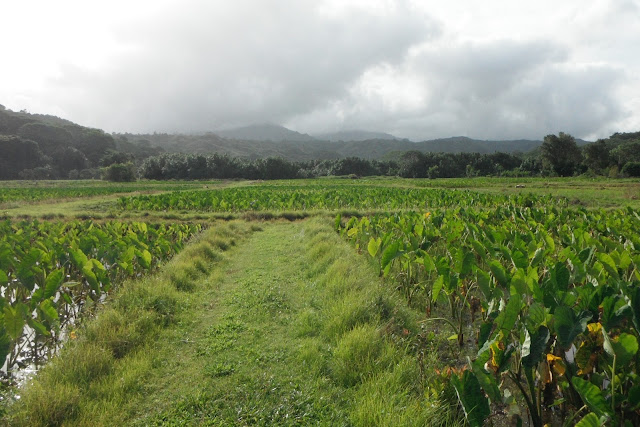Local wildlife: Hanalei Wetlands
Apparently, in December a few Koloa Ducks were found dead. The only way to test for the dreaded avian botulism that can devastate endangered populations such as the tenuous one in Hanalei is to inject a mouse with the bacteria and if it dies – uh oh! The birds are in severe danger. This endemic Hanalei population is the last of their breed, the other islands’ birds have been diluted with Mallards which they are able to interbreed with. In two months, just over 200 birds were found dead, sixty percent of which were the Koloa. The dead mouse test proved it was indeed botulism. Other wetland victims were Stilts, Moorhens, and Coots – all native to Hawaii
These ducks are very timid and usually flush 50 feet away even when hidden
that means this was a rare shot for me a couple years ago
I got a call asking if I was interested in transecting the valley wetlands on Thursday with a group of volunteers under the guidance of Fish and Wildlife personnel. Of course!
We met at 8:00am with water shoes or tabis, rain gear, and water to drink.
We were coached as to what we were looking for – the neurological disease attacks eyelids first, the feet before the wings – so we might see a bird propelling itself with its wings across water or mud instead of using its feet. The neck muscles go next and the head droops. A bird lying on its side or head down may not be dead yet. The important thing is to retrieve these animals before they are beset with maggots which spread the disease throughout the region.
I have to admit, I was thrilled at the prospect of being allowed into the refuge on the left side of Hanalei River
Hanalei River Valley - river on right
Wildlife refuge and taro farming
Interns Jennifer and Josh from AmeriCorps came by later to pick us up after searching from an ATV on the few wider dikes. They found one dead Koloa duck just beyond where I was headed, in the center of a dike checked the afternoon before. Large spoor nearby indicated that a wild boar had been through as well but I was assured that it would have eaten the hapless duck if their paths had crossed.
Dikes allow different water flow in each lohi where the taro is growing in stages
Some of the dikes were wide enough for the ATV but many were only footpaths
Our rendezvous was back at FWS office where the bird was identified, that is measured and photographed. It would be submitted to the dead mouse test to determine if it was in fact botulism. On hearing the news, wetland manager Mike Mitchell said finding this bird “stopped an outbreak” in that part of the valley.
Dead Koloa Duck - to be tested for avian botulism
Two sick birds that had been sent to the Humane Society on the other side of the island on Monday were returned as non-infected on Thursday, they had been hydrated and were brought back to Hanalei for release. They were also photographed and we tagged along with refuge biologist Kim Uyehara to release them near a pond.
Kim Uyehara, wildlife biologist holding rehabilitated Koloa Duck
Some of the animals are more skittish than others, this one calmed with the hood
The moment the doors were lifted out, one duck flew left, the other flew right
Freedom
After lunch we returned to work, this time in the larger area to the right of the river – a mixture of taro production and refuge wetland habitat reserved for the five endemic birds, all at risk.
More Lo'i
Hawaiian Gallinule or Common Moorhen (3) on right with red faces
Nene
I have many pictures of Nene standing, walking, sitting, even flyiing in blue sky but this guy taking off is what the wetlands are all about.
Hawaiian black-neck Stilts
We worked this section with a visual cross-section method, four people to a taro patch or lo'i (low-ee). Two people stood on opposite sides looking north/south; two others did the same looking east/west across the same lo'i. We all scanned with binoculars among and between the taro rows looking for sick or dead birds, moving laterally while checking each row.
We quickly realized how easy it would be to miss a sick bird among the shadows and fallen browned leaves of taro, so we took our time
Once we completed the taro patches we moved on to the grassy wetlands. These varied between shallow waters with clumps of sedge and various plants that benefit the birds to areas entirely drained and muddy to watery areas without much other than “islands” of plants that would easily hide a sick or dying bird. We lined up generally five meters apart unless the grasses were tall and/or thick and transected them one by one.
Sedges and bird friendly plants in the wetland habitat
Front to back: Kathy, Kim, Josh, Jennifer
we found plenty of invasive apple snails and no birds in the watery patches
Our goal had been to cover the entire refuge, inch by inch. We called it a day after 5pm when it was all too apparent we couldn’t finish. Kim assured us the remainder would be covered easily the next morning. The end result was positive – we had discovered only one dead bird and two healthy ones were re-released. Perhaps the worst of it was over. Very little is really known about the deadly bacteria and how to control it but it was believed that an unusually hot, dry season on the north shore had contributed to the outbreak.
I later learned that Pete Leary, biologist from Midway had stopped off in Hanalei to share his experience with avian botulism since he had faced a similar problem with Laysan Ducks on both Laysan Island and Midway Island

































